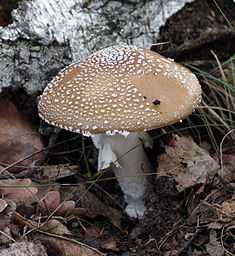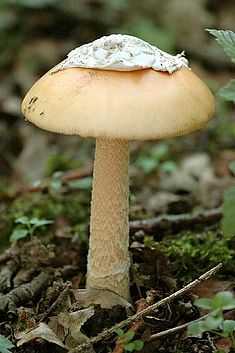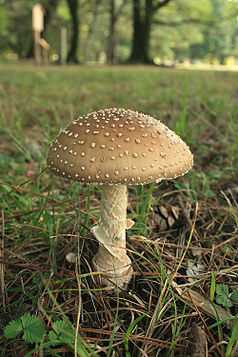Amanita pantherina var. pantherina
Amanita pantherina var. pantherina, also known as the panther cap and false blusher due to its similarity to the true blusher (Amanita rubescens), is a species of fungus found in Europe and Western Asia.
Description
- Cap: 4 – 11 cm wide, hemispheric at first, then convex to plano-convex, deep brown to hazel-brown to pale ochraceous brown, densely distributed warts that are pure white to sordid cream, minutely verruculose, floccose, easily removable. Viscid when wet, with a short striate margin. The flesh is white, unchanging when injured.
- Gills: free, close to crowded, white becoming greyish, truncate.
- Spores: white in deposit, broadly ellipsoid to ellipsoid to elongate, infrequently globose. 8 — 12 × 5.5 — 8 µm.
- Stipe: 5 – 14 cm long × .6 – 2 cm wide, subcyclindric, somewhat narrowing upward, white, becoming slightly tannish in age, stuffed then hollow, finely floccose becoming smooth above the ring, and with small appressed squamules or creamy floccose material below. The volva is white, becoming grey with age, forming one or sometimes two narrow hoop-like rings just above the bulbous base. The flesh is white, unchanging when injured.
- Odour: Unpleasant or like raw potatoes
- Microscopic features: Spores are 8-14 x 6-10 µm, smooth, elliptical and inamyloid.[1]
Other than the brownish cap with white warts, distinguishing features of Amanita pantherina include the collar-like roll of volval tissue at the top of the basal bulb, and the elliptical, inamyloid spores.
Habitat and distribution
The panther cap is an uncommon mushroom, found in both deciduous, especially beech and, less frequently, coniferous woodland and rarely meadows throughout Europe, western Asia in late summer and autumn.[2] It has also been recorded from South Africa, where it is thought to have been accidentally introduced with trees imported from Europe, and on Vancouver Island, in British Columbia, Canada. [3]
It is an ectomycorrhizal fungus, living in root symbiosis with a tree, deriving photosynthesised nutrients from it and providing soil nutrients in return.
Biochemistry
Amanita pantherina contains the psychoactive compound muscimol,[4] but is used as an entheogen much less often than the related Amanita muscaria.
See also
References
External links
|
|---|
| | Subgenus Amanita | Section Amanita | |
|---|
| Section Vaginatae | |
|---|
| Section Caesareae | |
|---|
| |
|---|
| | Subgenus Lepidella | Section Lepidella | |
|---|
| Section Amidella | |
|---|
| Section Phalloideae | |
|---|
| Section Validae | |
|---|
|
|---|
|
|
|---|
| sect.
Amanita | | |
|---|
| sect.
Phalloidea | | Species | | Destroying angels | |
|---|
| | Other members | |
|---|
|
|---|
| | Compounds | |
|---|
|
|---|
| sect.
Lepidella | | Species | |
|---|
| | Compounds |
- Allenic norleucine (2-amino-4,5-hexadienoic acid)
- Propargylglycine
|
|---|
|
|---|
| sect.
Validae | | Species |
- A. rubescens (A. amerirubescens nom. prov.)
|
|---|
| | Compounds | |
|---|
|
|---|
|




